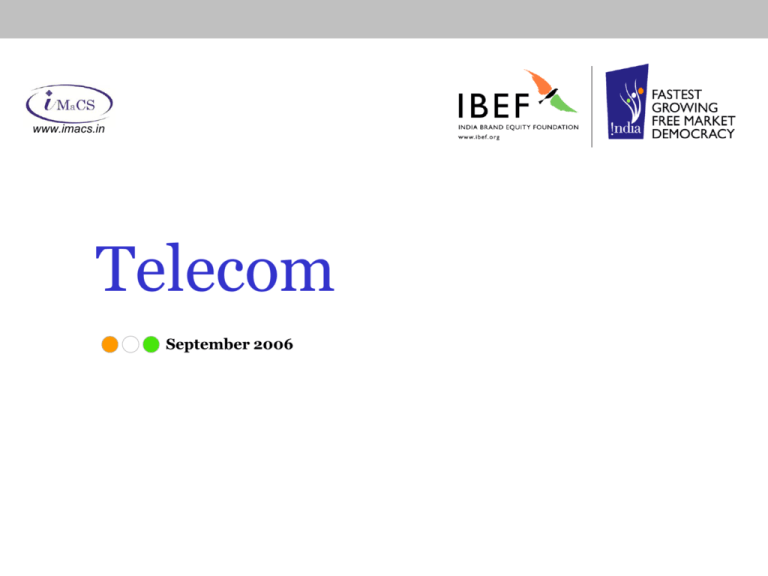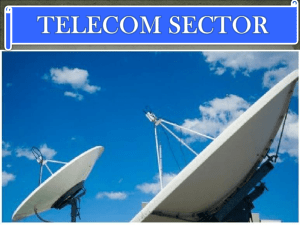
www.imacs.in
Telecom
September 2006
www.imacs.in
Contents
• Market Overview
• Government regulations & policy
• Advantage India and business
opportunities
TELECOM
www.imacs.in
Market
Overview
• Market Overview
• Government regulations & policy
• Advantage India and business opportunities
TELECOM
www.imacs.in
TELECOM
Market Overview
India’s telecom market has grown
rapidly in the last few years…
Subscriber growth
180
164
CAGR - 38 %
120
98
76
60
53
44
0
2002
2003
2004
2005
Aug-06
Revenue growth
20
20
CAGR - 21%
$ Billion
15
10
9
10
15
• Revenues ~ USD 19.5 bn (FY 2006)
• CAGR (FY 2002-06) - 21%
• Have doubled in last 3 years
• Subscribers ~ 160 million (Aug 2006)
• CAGR (FY 2002-06) - 38 %
• Nearly quadrupled since FY 02
• 5-6 million being added every month
• Tele-Density - 14.8 (Aug 2006)
• Has doubled in 3 years
• Target set for 2007 under NTP 1999
achieved during FY 2005
11
5
0
2002
2003
2004
2005
2006
Source: www.voicendata.com, Telecom regulatory Authority of India (TRAI),
Year indicates financial year ending March
www.imacs.in
TELECOM
Market Overview
…and is poised to be the second
largest network globally by 2008*
mn. subscribers
800
Telecom Subscribers - Country wise December 2005
China
743
India - Nov
2006
184 mn. subs
600
400
200
USA
360
Japan
153
Germany
134
Rus
130
Ind
125
0
Expected to overtake US by 2008
* Based on excerpts from Worldwide Wireless Data Trends 2006 - a mid year update. Datacomm research
Source: International Telecommunications Union (ITU)
www.imacs.in
TELECOM
Market Overview
Mobile telephony continues to be
the key growth driver…
• Intensifying competition
• 3 to 6 players per circle
• Presence of CDMA and GSM providers
• Significant share of private sector
• Growing affordability
• ARPUs among lowest in the world
• Lower cost of ownership due to Low cost / used
handsets
• Success of the pre-paid format
Subscriber Growth - Mobile vs Fixed
175
Mn. subscribers
• Progressive regulation
• Migration to revenue sharing
• Calling Party Pays (CPP) regime
• Unified access licensing
• Intra-circle merger guidelines
143
140
105
70
38
35
43
42
7
13
2002
2003
34
52
41
41
2005
2006
0
2004
Fixed (mn. subs)
Mobile (mn. subs)
Wireless emerging as the preferred mass market format service
providers focus on Internet / broadband access to improve fixed
line ARPU*
* Average Revenue per user
2006 figures as of Nov 2006
Source: TRAI
www.imacs.in
TELECOM
Market Overview
Growing network coverage is
triggering further market expansion
Segment
Cellular reach (2003-04)
Locations
Urban
Rural
~ 1700 of 5200
towns
Negligible
Cellular reach (End 2006 - Est.)
Population
Locations
Population
200 million
~ 4900 towns out
of nearly 5200
towns
300 million
Negligible
~ 350,000 out of
607,000 villages
450 million
Support from Universal Service Obligation Fund envisaged for shared network infrastructure creation
in uncovered rural areas
Source: Recommendations on Rural Telephony 2005 - TRAI
www.imacs.in
TELECOM
Market Overview
Vibrant and competitive telecom market
Company
Presence
Subscribers Jul
06 (mn)
Share (%)
Fixed
Mobile
Fixed
Mobile
BSNL
Government owned. Has ramped up GSM services. National
presence (except Mumbai and Delhi)
37.4
17.7
74.7%
19.6%
MTNL
Government owned. Operates in Delhi and Mumbai.
3.8
2.0
7.7%
2.3%
Bharti
Integrated operator, with presence in all sectors. Largest
mobile services provider.
1.4
19.6
2.7%
21.7%
Reliance
Integrated operator. Plans expansion of GSM network apart
from being the largest private CDMA operators.
3.0
17.3
6.0%
19.2%
Hutch
Pure play GSM operator in 11 circles.
15.4
17.0%
IDEA
Pure play GSM operator in 6 circles
7.4
8.2%
Tata
Teleservices
Integrated operator (along with VSNL) with presence in all
segments. Provides CDMA services in 20 circles
Aircel
Operates in 2 circles. Announced Plans to expand GSM
footprint in North and North east
2.6
2.9%
Spice
Pure play GSM player in 2 circles
1.9
2.1%
4.0
4.9
Others
0.4
1.4
Total
50
90
8.0%
5.4%
Consolidation leading to emergence of integrated pan-national service providers
Source: TRAI, IMaCS research
www.imacs.in
TELECOM
Market Overview
Several Indian firms gaining a
foothold in the global market
• Indian service providers acquiring scale in the International Long Distance market through acquisitions…
• Acquisitions - FLAG by Reliance, Tyco and Teleglobe by Videsh Sanchar Nigam Limited
• VSNL is now the world's fifth largest carrier of voice globally
• Reliance’s FLAG network connects with 28 countries. FLAG’s FALCON cable system when completed
would connect 12 countries with 25 international cable landing stations
• Investments in Infrastructure and
• Bharti-Singtel and VSNL investments in undersea cable
• Emerging as Integrated telco, positioning themselves as full service providers
• Tata teleservices-VSNL, Bharti, Reliance have end-to-end presence in ILD, NLD and Access;
announced plans to get into ILD
• Focus on corporate connectivity - IPLCs, Frame relay, VPNs
• Strong thrust on internet and broadband - both corporate and retail segments
BSNL has
www.imacs.in
TELECOM
Government
regulations and policy
• Market Overview
• Government regulations & policy
• Advantage India and business opportunities
www.imacs.in
TELECOM
Government Regulations and policy
Reform thrust on independent regulation,
competition and investment facilitation
•
•
•
Pre-reform
Partial Deregulation
Further Deregulation
Take-off
Pre-1994
1994-1999
1999 - 2002
2002 onwards
MTNL - Mumbai and
Delhi; DTS elsewhere
No mobile service
NLD - DoT per/ BSNL
ILD - VSNL
•
4 private fixed service
providers with less
than 1% market share
•
2 GSM mobile players
in each circle
•
13 players start
mobile service
• National Telecom Policy
(NTP) 1994
• TRAI constituted 1997
National Telecom
Policy, 1994
•
Licenses converted to revenue
sharing
•
Private sector share less than 5%
in revenue terms
•
•
•
Competition in NLD and ILD
•
•
•
•
Licenses on Revenue share
4 mobile operators / circle
NTP 1999
BSNL formed 2001
Internet Telephony 2002
FDI - 49 %
New Telecom
Policy, 1999
•
•
•
Calling Party Pays
•
Intra-circle merger
guidelines
•
Unified Licensing
CDMA launch
3-6 operators in each
circle
• Broadband policy 2004
• FDI - 74% 2005
Unified Licensing
Regime
www.imacs.in
TELECOM
Government Regulations and policy
Independent regulation has been a
critical factor in growth
2006
Number portability
Convergence
TRAI’s recommendations
2005
Unified Licensing
Quality of Service regulation
Rural Telephony
2004
Intra-circle merger guidelines
Internet / broadband penetration
2003
Calling Party Pays Regime
Unified Access Licensing
Reference Interconnect Order
2002
• ILD opened to competition
• Internet Telephony allowed.
• Reduction in License fees
Mature regulatory regime and an enabling policy
framework already in place
www.imacs.in
TELECOM
Government Regulations and policy
Important policy initiatives
•
•
•
•
•
•
•
•
Broadband policy unveiled in 2004 - Targets 20 million broadband subscribers by 2010
Focus on making India a regional Telecom manufacturing hub
FDI limit increased from 49% to 74%
100% FDI permitted under automatic route in the manufacturing sector
Deregulation virtually complete and Unified Licensing regime
Interconnection Usage Charge framework in place
Exemption from customs duty for import of Mobile Switching Centres
Comprehensive Spectrum policy and 3G policy on the anvil
Creating a favourable investment climate to support growth
www.imacs.in
TELECOM
Advantage India and
business opportunities
• Market Overview
• Government regulations & policy
• Advantage India and business opportunities
www.imacs.in
TELECOM
Advantage India and business opportunities
Recent developments are
indicative of the paradigm shift in
wireless growth
• Of the 160 million subscribers, more than
India China comparison
90 million subscribers added in the last
two years
Million Subscribers
500
• More than 5 million subscribers added
every month since Dec. 2005, translating
into the highest growth rate in the world
250
China
India
0
1
2
3
4
5
6
7
8
• On a comparison of growth since
introduction of mobile telephony, India
surpasses China at the same stage of
market evolution
9 10 11 12 13 14 15 16 17 18
Year
In the 11th year
India - 76 mn.
China - 24 mn.
Source:TRAI
www.imacs.in
TELECOM
Advantage India and business opportunities
Mobile Value Added Services (VAS)
set to register explosive growth*
• Data and VAS contributed to 7% of revenue in 2004
• Messaging and music (ringtones, downloads etc) to be key contributors
• VAS revenues expected to grow given
• Demand - Young population (60% < 30 years) and an affinity to music and movies
• Supply - aggressive pricing, vibrant ecosystem of content providers /
broadcasters, declining GPRS/mp3 handset prices
• Indian Idol - a reality show on Sony Television got 55 million SMS
messages in 5 months
• Radio Mirchi - a popular FM radio channel receives ~
40000-45000 SMS messages every day
• R-World - the mobile portal of Reliance Communications
had 5.3 million visitors out of its 18 million subscribers in 2005
VAS expected to contribute 20% of revenue by 2008 and 30% by 2010
* Excerpts from Mobile Data in India. Lehmann brothers report. Oct 2005. IMaCS research
www.imacs.in
TELECOM
Advantage India and business opportunities
Broadband and Internet connectivity
on the verge of a take-off
Mn. subscribers
Broadband subscriber growth
2.00
• Internet / Broadband market (FY 2006)
• 6.94 mn.Internet customers
•
1.38
1.5
•
6-fold
growth
0.75
•
• Broadband Policy 2004
• Recognises the importance of
0.18
0
Mar-05
(25% growth YoY)
1.35 mn. broadband customers
(6-fold growth YoY)
Incumbents (BSNL / MTNL)
dominate - 66% share
7-fold growth in broadband
connections during FY 2006
Mar-06
Nov-06
Growing PC sales, Internet adoption in small
towns and offerings including triple play and
•
•
internet penetration
Envisages 40 million internet
connections by 2010
Visualises creation of infrastructure
through various access technologies
video-on-demand / IPTV expected to be major
growth drivers
Source: TRAI
www.imacs.in
TELECOM
Advantage India and business opportunities
Growth-driving sustainable factors
in the telecom sector
• Favorable Macro-Economic fundamentals and
Demographics
• Strong Economic Growth and rising incomes
• By 2020, working age population to
rise to 65%
• Low tele-density relative to Asian peers
•
India not just a cost-sensitive mass market
•
300 million plus middle class population
•
Value added service revenue expected to grow at
80% CAGR over next 5 years.
•
IDC estimates phones with color screens/
cameras to account for 30%of handset sales in
• Progressive policy and regulation
• Independent regulation
• Consistent policy framework
• Favourable Investment Climate
• Rising Affordability
• Declining ARPUs
• Lowering cost of handsets
• Growing popularity of pre-paid format
2005 and 62%by 2008
“People think about the Indian market as a lower tier.
About 30%of the U.S. market is high end and maybe
it's only 5%in India. But India has 1.1 billion people”
Ron Garriques. Executive vice president,
Motorola's personal communications sector in
On the Razor's Edge:Cell Phones Morph into Hip
Consumer Electronics Devices Knowledge@Wharton
www.imacs.in
TELECOM
Advantage India and business opportunities
India poised to be a USD 40 bn - 45
bn telecom market by FY 2010…
Telecom sector targets announced by Government of India
•
•
•
•
•
250 million subscribers by 2007
500 million subscribers by 2010
20 million broadband subscribers by 2010
Mobile access to all villages with population more than 5,000 by 2006
Mobile access to all villages with population of more than 1,000 by 2007
Translating into an investment requirement of USD 25 bn to USD 30 bn…
www.imacs.in
TELECOM
Advantage India and business opportunities
A compelling destination for
Telecom service providers and
equipment majors
• Largest pure-play GSM service provider in India
• Has over 15 million subscribers
• Has a 10% stake in Bharti telecom, an integrated service provider
• Represents the largest foreign investment in the telecom services
sector in India
• Promotes and supports a range of telecommunications products and services in
India in association with licensed operators.
• Has invested in Bharti Airtel and also Network i2i is a 50:50 Joint Venture
between Bharti and SingTel, connecting Chennai to Singapore
• Nortel offers a suite of products and solutions across two broad categories
Carrier Networks (incorporating Wireless Networks, Wireline Networks and
Optical Networks) and Enterprise Networks.
• In India since 1991. Has an R&D centre in Bangalore
www.imacs.in
TELECOM
Advantage India and business opportunities
Key Indian Companies
•
BSNL - Incumbent service provider and World's 7th largest Telecommunications Company
providing comprehensive range of telecom services in India
•
Services include Wireline, CDMA mobile, GSM Mobile, Internet, Broadband, Carrier service,
MPLS-VPN, VSAT, VoIP services, IN Services etc.
•
•
MTNL - State owned operator covering the cities of Mumbai an Delhi
•
•
Bharti Airtel - Integrated operator with presence in all segments
•
•
Reliance Communications - Largest player in India in the CDMA segment
•
•
Tata Teleservices - Integrated operator (with VSNL) with presence in all segments
Provides both fixed and mobile services
Leads the mobile segment in the country
Plans a GSM network
Provides CDMA services in 20 circles
www.imacs.in
The India Brand Equity Foundation is a public-private partnership
between the Ministry of Commerce & Industry, Government of India
and the Confederation of Indian Industry. The Foundation’s primary
objective is to build positive economic perceptions of India globally
India Brand Equity Foundation
c/o Confederation of Indian Industry
249-F Sector 18, Udyog Vihar Phase IV
Gurgaon 122015, Haryana, INDIA
Tel +91 124 401 4087, 4060 - 67
Fax +91 124 401 3873
Email j.bhuyan@ciionline.org
Web www.ibef.org
TELECOM
www.imacs.in
TELECOM
ICRA Management Consulting Services Limited
Disclaimer
This publication has been prepared by ICRA Management Consulting Services (IMaCS) for the India Brand
Equity Foundation (“IBEF”).
All rights reserved. All copyright in this publication and related works are jointly owned by IBEF and IMaCS.
The same may not be reproduced, wholly or in part in any material form (including photocopying or storing
it in any medium by electronic means and whether or not transiently or incidentally to some other use of this
publication), modified or in any manner communicated to any third party except with the written approval of
IBEF.
This publication is for information purposes only. While due care has been taken during the compilation of
this publication to ensure that the information is accurate to the best of knowledge and belief of IBEF and
IMaCS, the content is not to be construed in any manner whatsoever as a substitute for professional advice.
IBEF and IMaCS neither recommend nor endorse any specific products or services that may have been
mentioned in this publication and nor do they assume any liability or responsibility for the outcome of
decisions taken as a result of any reliance placed on this publication.
IBEF or IMaCS shall in no way, be liable for any direct or indirect damages that may arise due to any act or
omission on the part of the user due to any reliance placed or guidance taken from any portion of this
publication.







